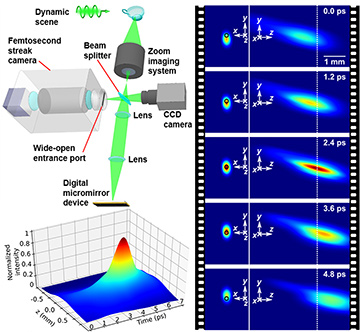 Top left: Schematic of the T-CUP system. Right: Real-time visualization of temporal focusing of a femtosecond laser pulse from the front (first column) and the side (second column) at 2.5 trillion frames per second. Bottom left: Dynamics of pulse intensity along the optical axis as a function of time and distance near the temporal focusing plane (white dashed line). [Image adapted from reference 4.] [Enlarge figure]
Top left: Schematic of the T-CUP system. Right: Real-time visualization of temporal focusing of a femtosecond laser pulse from the front (first column) and the side (second column) at 2.5 trillion frames per second. Bottom left: Dynamics of pulse intensity along the optical axis as a function of time and distance near the temporal focusing plane (white dashed line). [Image adapted from reference 4.] [Enlarge figure]
Rooted in the physics of space-time duality,1 temporal focusing—a time-domain counterpart of spatial focusing—has found diverse applications in nonlinear microscopy and materials processing. Temporal-focusing events are often non-repeatable, which precludes scrutinizing the propagation of ultrashort laser pulses in living biological tissue2 and investigating the elusive physics of strong-field interactions with matter.3
To address these challenges, the first step is to visualize temporal focusing in real time. Yet the transient changes in the width and intensity of an ultrashort laser pulse during light-speed temporal focusing require femtosecond-scale frame intervals in a single camera exposure. Existing imaging techniques fall short of these requirements, as they either need numerous repeated measurements or have insufficient imaging speeds to record these dynamic scenes.
To overcome these limitations, we recently developed trillion-frame-per-second compressed ultrafast photography (T-CUP), which can achieve single-shot, real-time imaging speed of up to 10 trillion frames per second (Tfps)—100 times greater than the fastest camera to date.4,5 T-CUP’s unprecedented imaging ability stems both from its novel operating principle and its state-of-the-art hardware. In particular, T-CUP brings together the concepts of compressed sensing and the Radon transformation, which uses only two projections to reconstruct a high-quality 3-D spatiotemporal data cube. The T-CUP system is also built on a femtosecond streak camera, which provides the fastest possible temporal shearing to achieve Tfps imaging speeds.
We have used T-CUP to achieve real-time imaging of temporal focusing of a single femtosecond laser pulse. For front-view detection, T-CUP captured a tilted laser pulse front sweeping along the vertical axis of the temporal focusing plane. For side-view detection, T-CUP revealed the full evolution of a temporally focused pulse propagating through a dynamic scattering medium. We analyzed this non-repeatable temporal focusing using the captured details in the pulse front, the intensity dynamics and the transverse profiles of the laser pulse.
As the only technology now capable of observing temporal focusing in real time, T-CUP could, we believe, find widespread applications in metrology, biomedicine and materials science. Moreover, as a generic imaging platform with salient advantages of ultrafast, receive-only and single-shot imaging, T-CUP appears poised for studying various non-repeatable light-speed events.
Researchers
Jinyang Liang, Institut National de la Recherche Scientifique, Varennes, Québec, Canada
Liren Zhu and Lihong V. Wang, California Institute of Technology, Pasadena, Calif., USA
References
1. R. Salem et al. Adv. Opt. Photon. 5, 274 (2013).
2. C. Stockbridge et al. Opt. Express 20, 15086 (2012).
3. Z. Wang et al. Opt. Lett. 40, 5726 (2015).
4. J. Liang et al. Light Sci. Appl. 7, 42 (2018).
5. L. Gao et al. Nature 516, 74 (2014).
